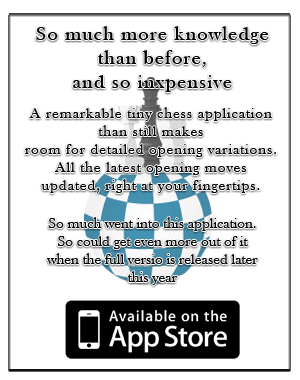GRASSHOPPER
A fairy piece invented by T. R. Dawson in 1913 in the Cheltenham Examiner newspaper. The Grasshopper, which in diagrams has the symbol of an upside-down Queen and in texts the letter G, belongs in the category of the hoppers. It moves along Queen lines, but must hop over another piece of either colour and land on the next square beyond. If that square is occupied by a piece of the same colour as the grasshopper the move is not playable.  T. R. Dawson, British Chess Magazine, 1943 Mate in 2. (Grasshoppers). 1+3 grasshopper [8/7p/7K/1g2Sbp1/G3g1Sk/2B3gp/8/6s1] The Grasshopper Gb5 is threatening Bf5. The Grasshopper Ga4 can move to c6 and f4. The Grasshopper Ge4 can move to e6 and g6 (not to h4). The Grasshopper Gg3 can move to b3 and d6 (not to g5). The Grasshopper Ga4 keeps the Ge4 pinned because, if Ge4 is lifted, then Ga4 is threatening Kh4 which is exactly behind the hurdle Sg4. There are some tries: [1.Bxe4? ( > 2 Be4~#) Se2!], [1 Sf3+? Sxf3!], [1 Sg6+? hxg6!], [1 Sh2? Gxf5!], [1 Gf4+? gxf4!]. Key: 1 Se3! It so happens that the key unpins Ge4 (!), but black is in zugzwang. In the next three variations white forms battery arriving on the line of Ga4, and removing at the same time the hurdle of the black G which has moved but it cannot come back! 1…Ge6 2 S5g4# (if Ge6xg4 is played, the Grasshopper from e6 becomes the hurdle for Ga4). 1…Gg6 2 Bg4# 1…Ge2 2 S3g4# Other variations: [1…Sg1~ 2 S(x)f3#], [1…Gg3~ 2 Be1#], [1…h2 2 Sg2#], [1…Gxf5 2 Sxf5#], [1…g4 2 Gf4#].
T. R. Dawson, British Chess Magazine, 1943 Mate in 2. (Grasshoppers). 1+3 grasshopper [8/7p/7K/1g2Sbp1/G3g1Sk/2B3gp/8/6s1] The Grasshopper Gb5 is threatening Bf5. The Grasshopper Ga4 can move to c6 and f4. The Grasshopper Ge4 can move to e6 and g6 (not to h4). The Grasshopper Gg3 can move to b3 and d6 (not to g5). The Grasshopper Ga4 keeps the Ge4 pinned because, if Ge4 is lifted, then Ga4 is threatening Kh4 which is exactly behind the hurdle Sg4. There are some tries: [1.Bxe4? ( > 2 Be4~#) Se2!], [1 Sf3+? Sxf3!], [1 Sg6+? hxg6!], [1 Sh2? Gxf5!], [1 Gf4+? gxf4!]. Key: 1 Se3! It so happens that the key unpins Ge4 (!), but black is in zugzwang. In the next three variations white forms battery arriving on the line of Ga4, and removing at the same time the hurdle of the black G which has moved but it cannot come back! 1…Ge6 2 S5g4# (if Ge6xg4 is played, the Grasshopper from e6 becomes the hurdle for Ga4). 1…Gg6 2 Bg4# 1…Ge2 2 S3g4# Other variations: [1…Sg1~ 2 S(x)f3#], [1…Gg3~ 2 Be1#], [1…h2 2 Sg2#], [1…Gxf5 2 Sxf5#], [1…g4 2 Gf4#].



